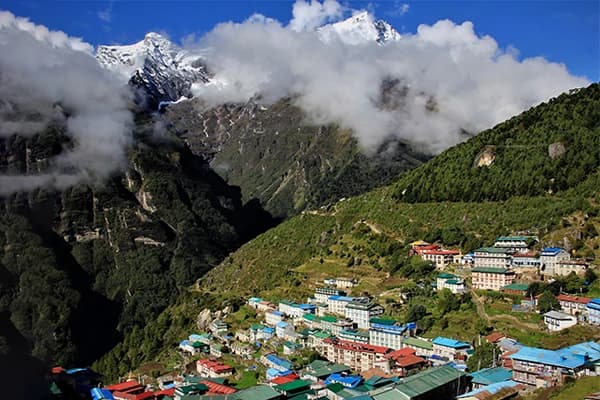Details of the Newly Added Peaks
The newly added peaks are listed below with their respective heights and small details.
Yalung Khang is a peak located within the Kanchenjunga range. The height of the Yalung Khang peak is 8,505 meters. This peak is also called Yalungkar. The first summit of this peak was done by Yutaka Ageta and Takao Matsuda on May 14, 1973.
Yalung Khang West is a peak situated at a height of 8,077 meters. It is the sub-peak of Yalung lhang. Yalung Khang West is also located in the Kanchenjunga Himalayan range.
Kanchenjunga Central is a prominent peak of the Kanchenjunga Himalayas added to the eight-thousander’s list. It is located on the border of Nepal and india. The altitude level at which the Kanchenjunga central sits is 8476 meters.
The first summit of the Kanchenjunga central was done by Wojciech Branski, Zygmunt Heinrich, and Kazimierz Olech on May 22, 1978.
Kanchenjunga South is also located on the Nepal-India border. The height of the Kanchenjunga south is 8,476 meters. The Kanchenjunga south falls in the Kanchenjunga Himalayan range. The first summit of Kanchenjunga South was done by Eugeniusz Chrobak and Wojciech Wroz on May 19, 1978. The
The Lhotse middle is the prominent peak of the Mahalangur Himalayan range. The height of the Lhotse middle is 8413 meters. This peak lies near the lhotse. The Lhotse middle is known for its unique climbing routes.
The first summiters of the Lhotse middle were Sergei Timofeev, Alexei Bolotov, Piotr Kouznetsov, and Evgeni Vinogradski on May 23, 2001.
Lhotse Shar is the last peak that is included in the eight-thousander’s list. It is close to lhotse. The height of the Lhotse Shar is 8,400 meters.
Implications for Mountaineers and Adventure Tourism
The recent announcement of the six new peaks as an eight-thousander in Nepal has important implications for the mountaineers and the adventure tourism. The first benefit of this announcement is there will be less congestion on popular summits like everest.
The identification of the new peaks opens new routes and offers unique climbing experiences. The climbers will get to experience the fresh challenges. There will be new challenges and environments for the adventure lovers.
Furthermore, each peak presents distinct technical challenges. Those challenges may be varying weather patterns, altitude acclimatization needs, and specific climbing techniques. Experienced climbers can sharpen their skills on different types of ascents.
The announcement is likely to attract the new commerrs. This can lead to a surge in adventure tourism. The local economies can benefit from the sed tourism-related activities such as guiding services, accommodation, and equipment rentals.
The jobs for the guides, porters and other posts are to be opened if these peaks are globally recognized. By this, Nepalese adventure tourism will get a boost.
Additional Challenges and Risks in Climbing These Peaks
All the previous eight-thousanders are known to the all. The challenges and risks associated with the previous peaks. However, the newly recognized peaks are yet to be studied fully and may be less known to some climbers.
All the peaks above 8,000 meters are prone to severe altitude sickness due to low oxygen levels. It is a well-known fact. But the weather conditions of the newly discovered peaks may be different than those of the previously discovered ones, like Everest and annapurna.
The new peaks may present the present technical climbing challenges like steep slopes, glaciers, and icy areas. The new peaks are less explored. So, there will also be additional challenges regarding route finding and assessing the safest paths to the summit.
Furthermore, there is a lack of established routes or adequate infrastructure like base camps, supplies, and rescue services for climbers during the climbing of some newly recognized peaks.
Like this, there are several additional challenges and risks associated with the newly recognized peak climbing along with other general risks and challenges. Proper preparation, experience, and awareness of these challenges are important for a successful expedition.
Government and Local Authorities’ Role
The role of the recognition and promotion of the newly added eight-thousanders in Nepal by the government and local authorities is important. It is important for both the mountaineering industry and broader tourism development.
The collaborative effort of the government with the experts from various sectors to gather data and assess the peaks is important for the facilitation of international recognition.
Furthermore, the promotion of the additional climbing options from the local authorities can help distribute income and employment opportunities across various regions. It will also help remove the congestion on popular peaks like Everest.
The role of the local authorities in ensuring the safety protocols is huge. It is for the safety of the climbers. This includes rescue services and emergency response plans tailored to the specific challenges presented by these new summits.
The collaboration with the international organizations, such as the International Mountaineering and Climbing Federation (UIAA), is possible only through the government level.
Plus, the environmental risks associated with the new peak climbing are huge. Only with the support of the government and local authorities is it is possible.
Conclusion
Nepal's official recognition of six additional eight-thousanders, primarily in the Kanchenjunga and Lhotse ranges, underscores the nation's commitment to mountaineering and tourism. This initiative not only diversifies climbing opportunities but also has the potential to boost local economies through increased adventure tourism.





